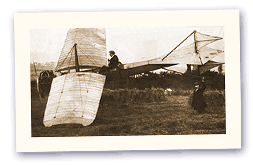 |
 | |||
 1884-1960 INVENTOR Ferguson was born at Growell, near Hillsborough, Co Down, on 4 November l884. In l902, he joined his brother Joe in a car and bicycle repair business in Belfast, and in 1904 began to race motor-cycles. In 1909, at Hillsborough, he made the first powered flight in Ireland, travelling 130 yd (118.5 m) in a monoplane he had built. He later drove racing cars, and helped to establish the famous Ulster Tourist Trophy races in 1928.
Ferguson formed his own motor business in 1911, and during World War 1 began to sell tractors to Irish farmers accustomed to horse-drawn ploughs. With the revolutionary concept that tractor and plough should be designed as a unit, Ferguson began to register his own patents.
This photograph was taken in 1910, after one of the first air flights in Ireland. The pilot, Harry Ferguson, had constructed the aeroplane from plans in a magazine and he made the first flight in the country at Hillsborough, Co. Down, on 31st December 1909.
Ferguson's later years were clouded by a dispute with the Ford Motor Company, after Henry Ford's death. He won $9.25m compensation in 1952, but a 1953 merger with the Canadian Massey-Harris concern worked out unhappily for him, and he retired to Stow-on-the-Wold, in Gloucestershire. His last ambition was to improve car safety through a four-wheel drive system and anti-lock braking, but he failed to make a commercial breakthrough. He suffered from insomnia and depression and, when he died from a drugs overdose on 25 October 1960, a coroner's jury returned an open verdict.
Read
From the Appletree Press title: Famous Irish Lives. |
[ Back to Top ]
All Material © 1999-2005 Irelandseye.com and contributors

 The American tycoon Henry Ford offered him a job, but he preferred his independence and set up an American plant to make Ferguson ploughs. In 1926, the principal patent of the Ferguson system - hydraulic regulation of the working depth of the various implements linked to the tractor - was granted. In time, the system would change the face of agriculture, but commercial success proved elusive.
The American tycoon Henry Ford offered him a job, but he preferred his independence and set up an American plant to make Ferguson ploughs. In 1926, the principal patent of the Ferguson system - hydraulic regulation of the working depth of the various implements linked to the tractor - was granted. In time, the system would change the face of agriculture, but commercial success proved elusive.